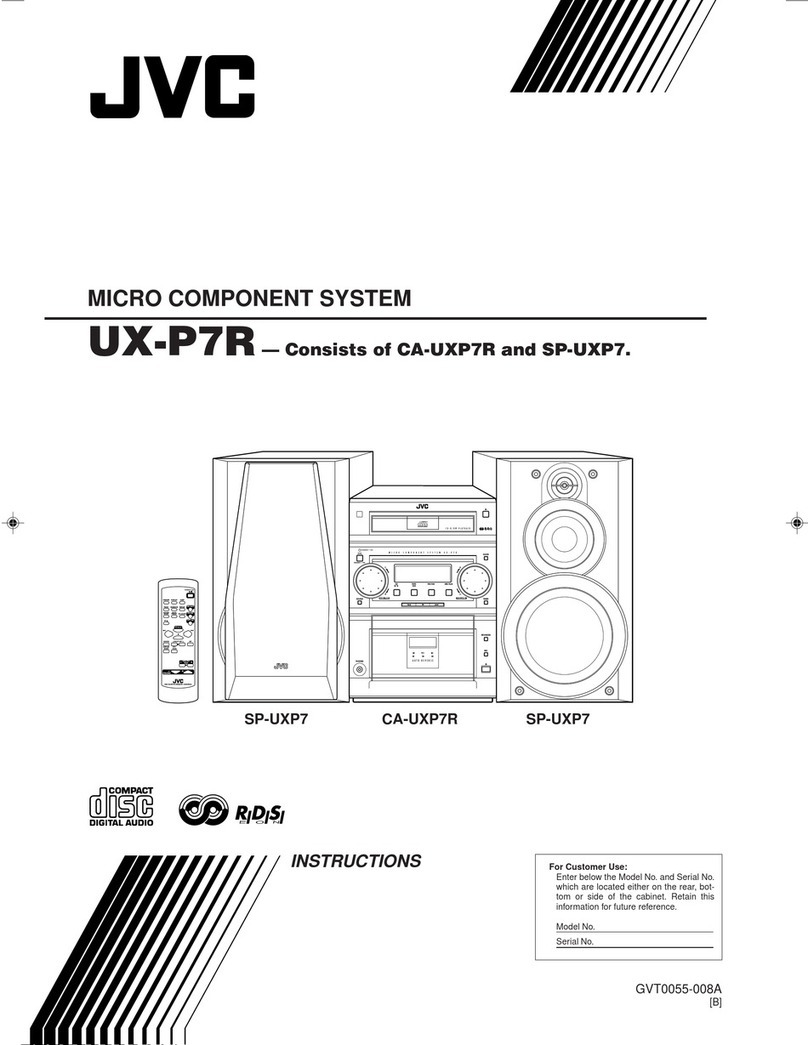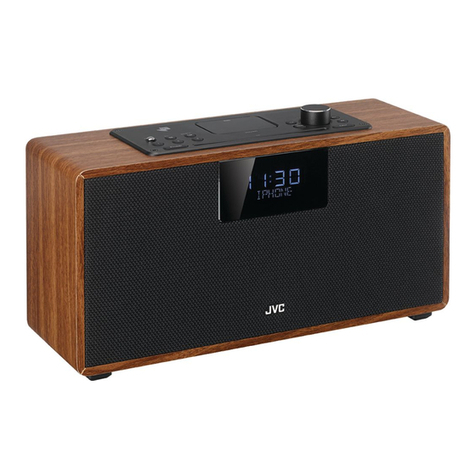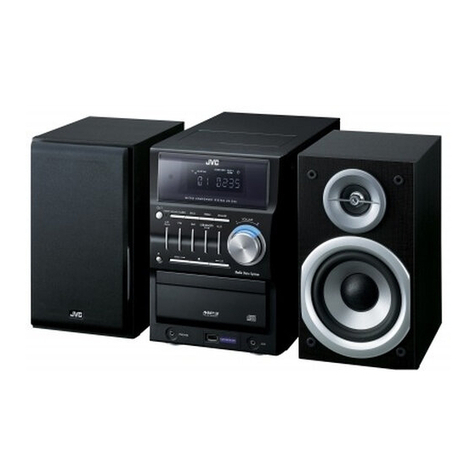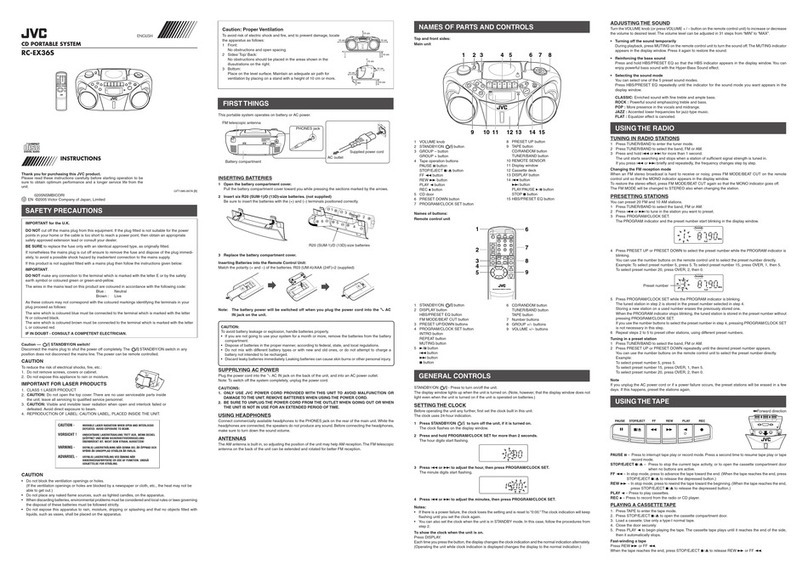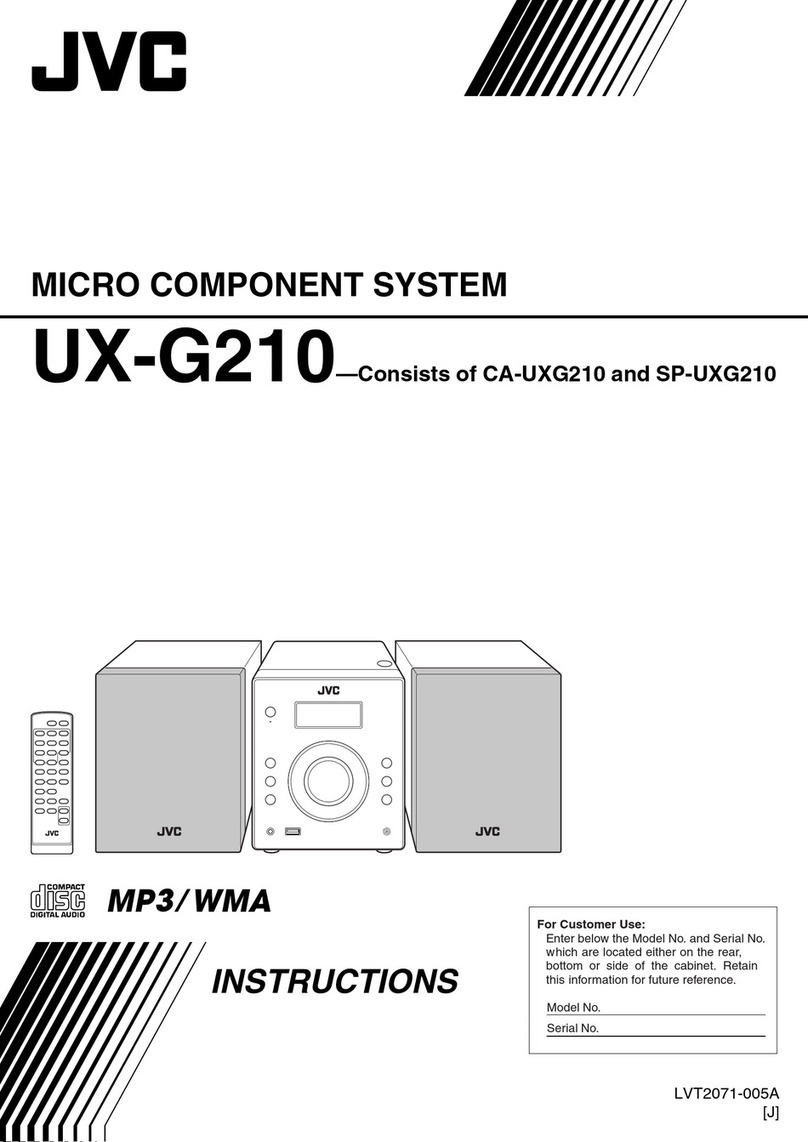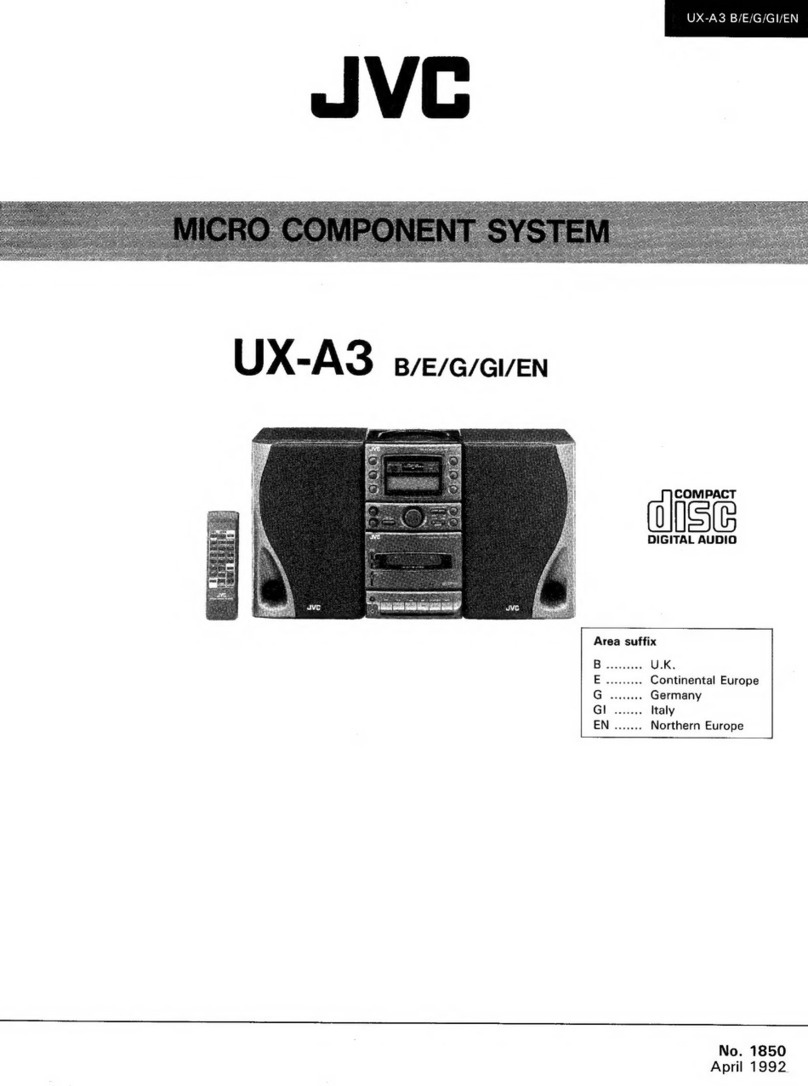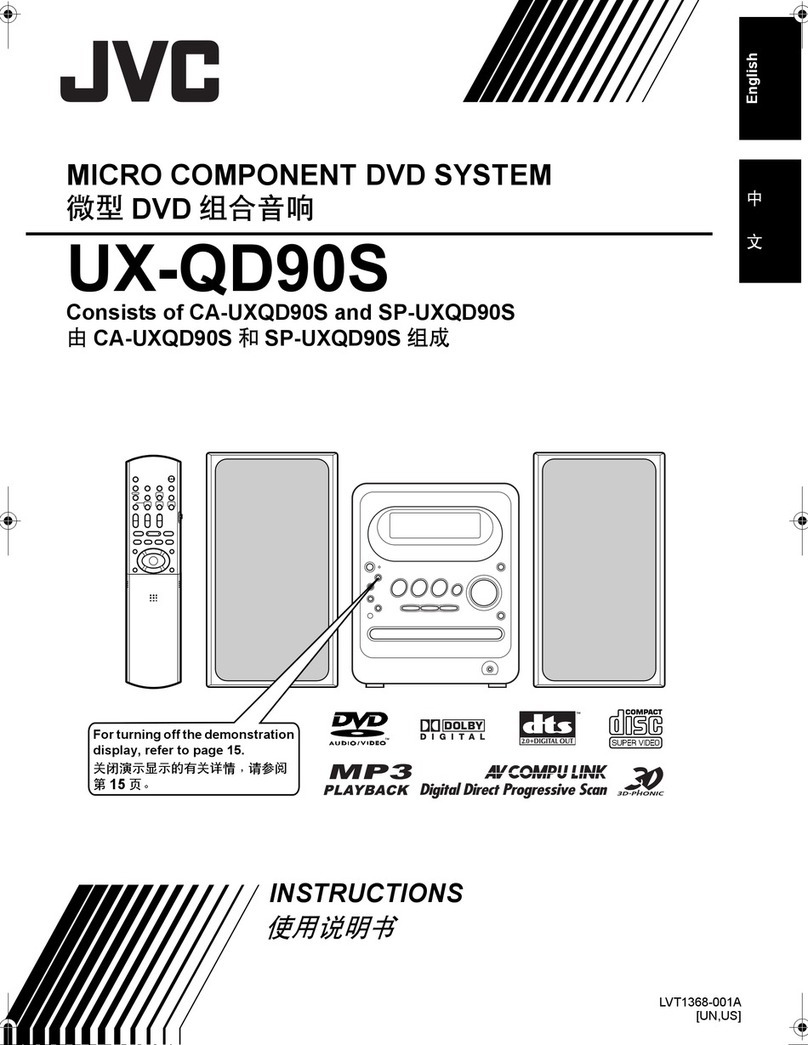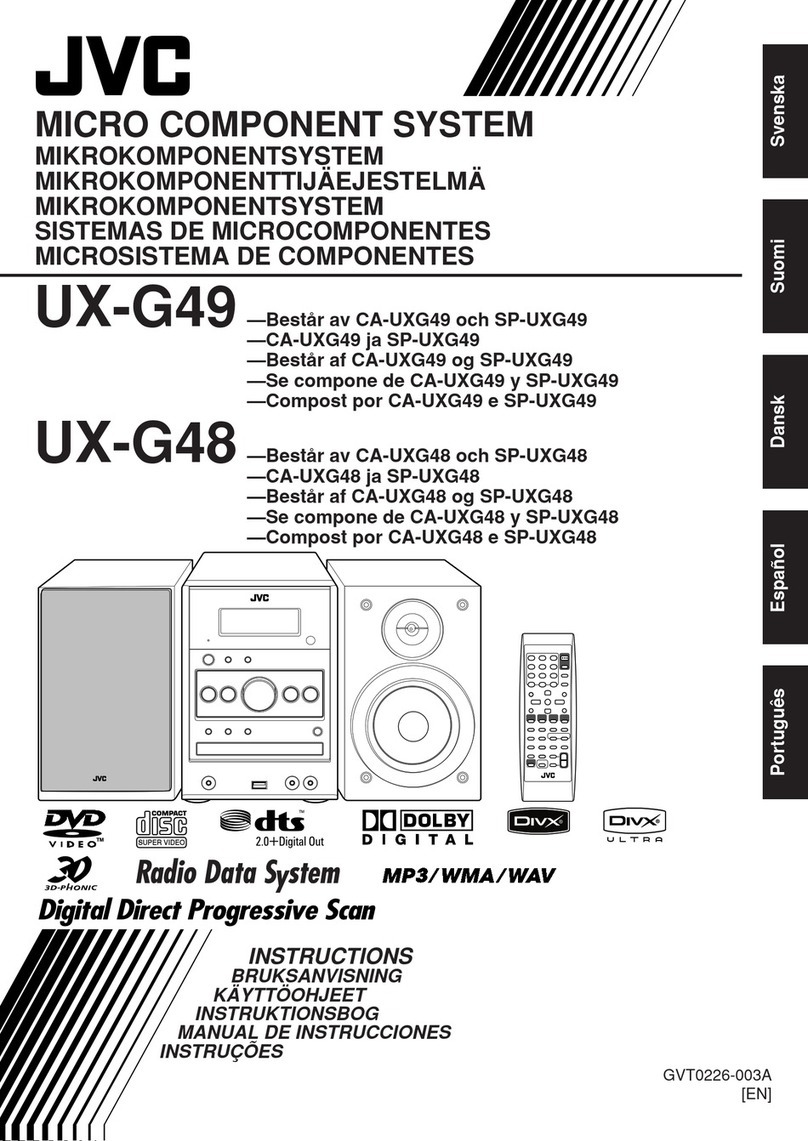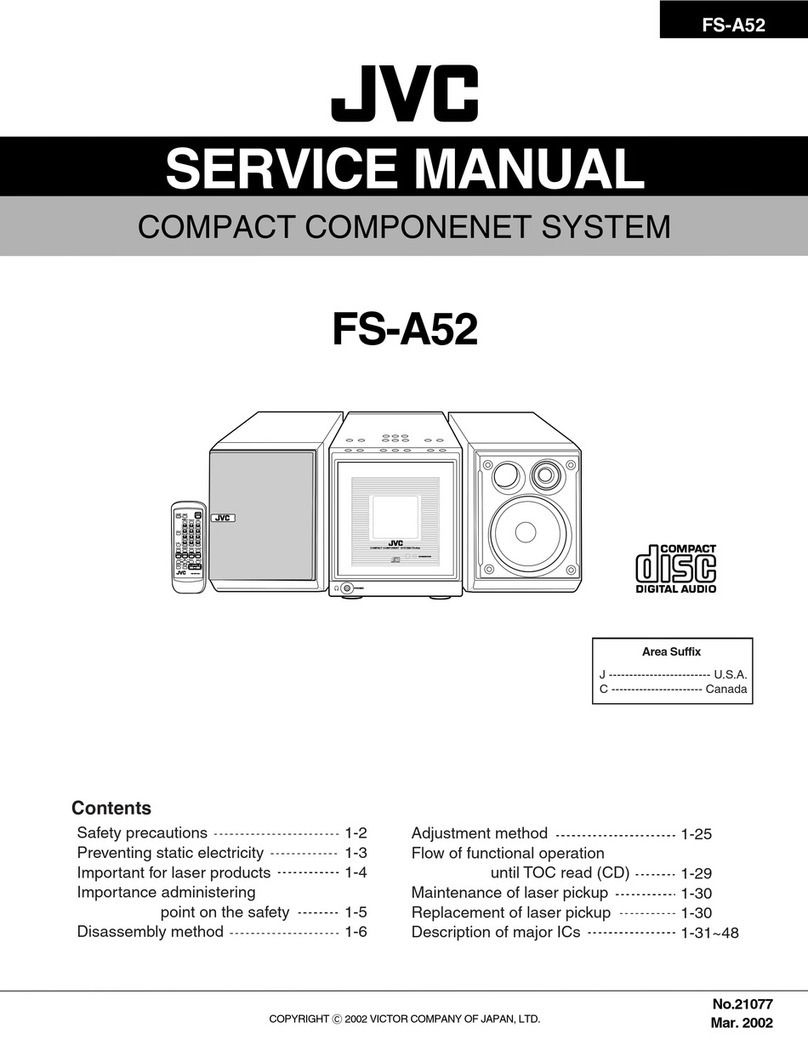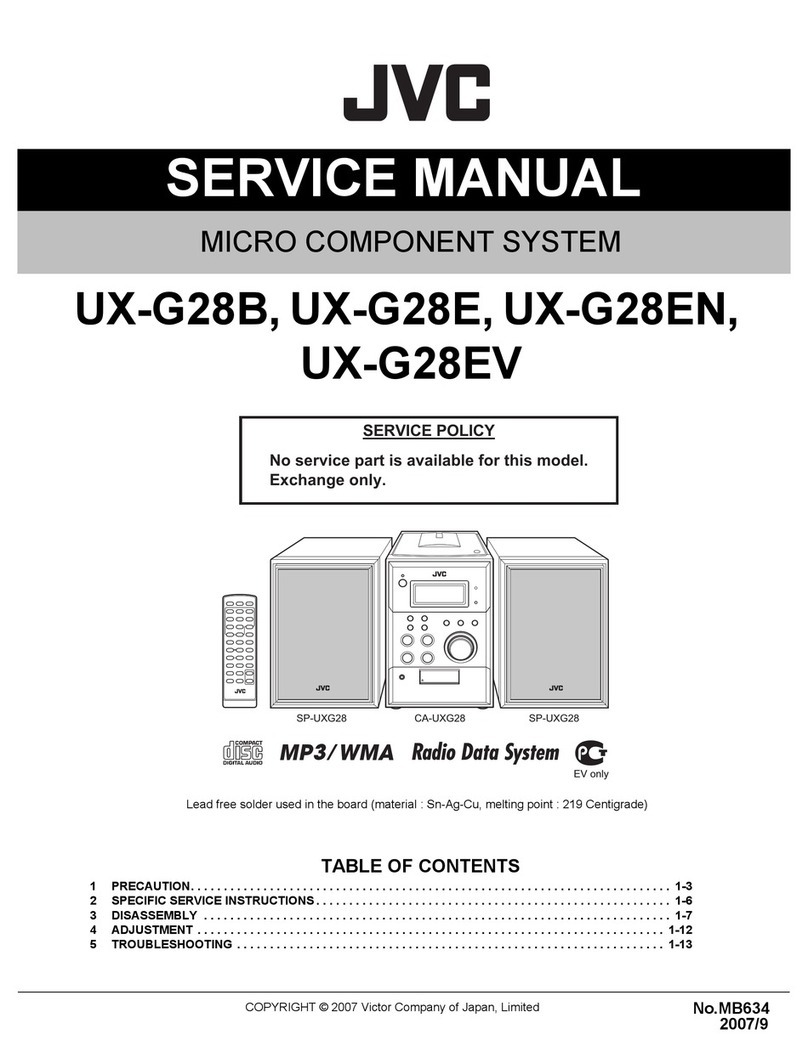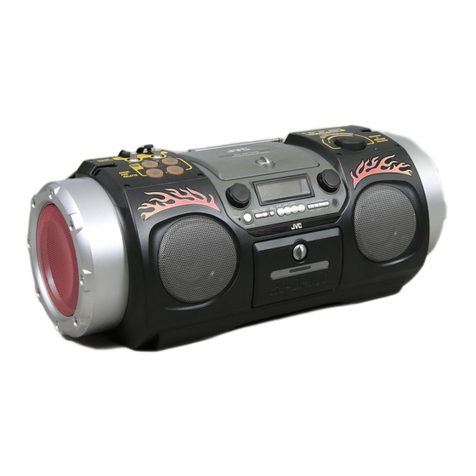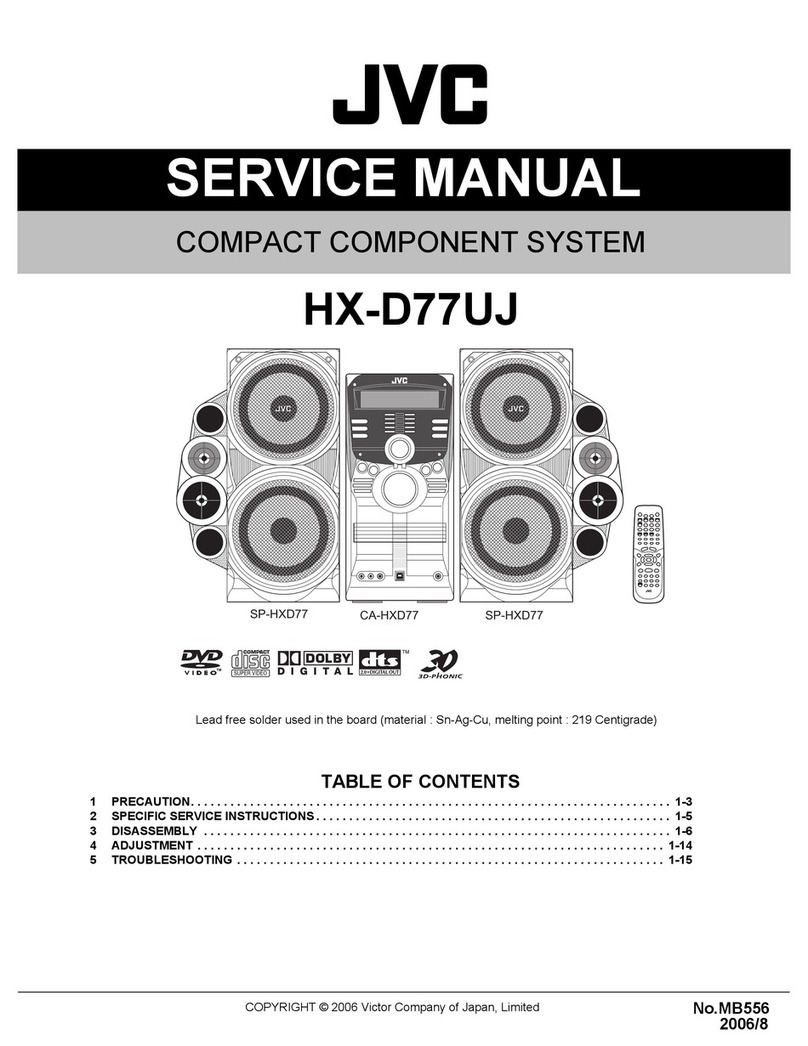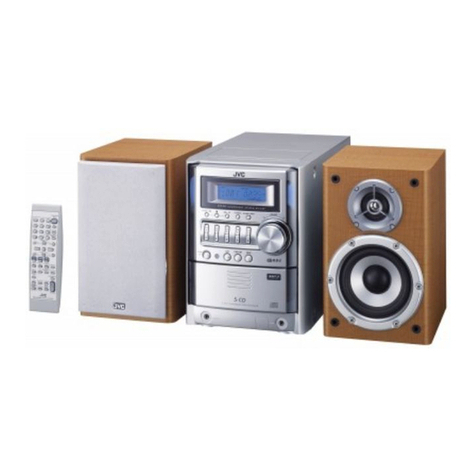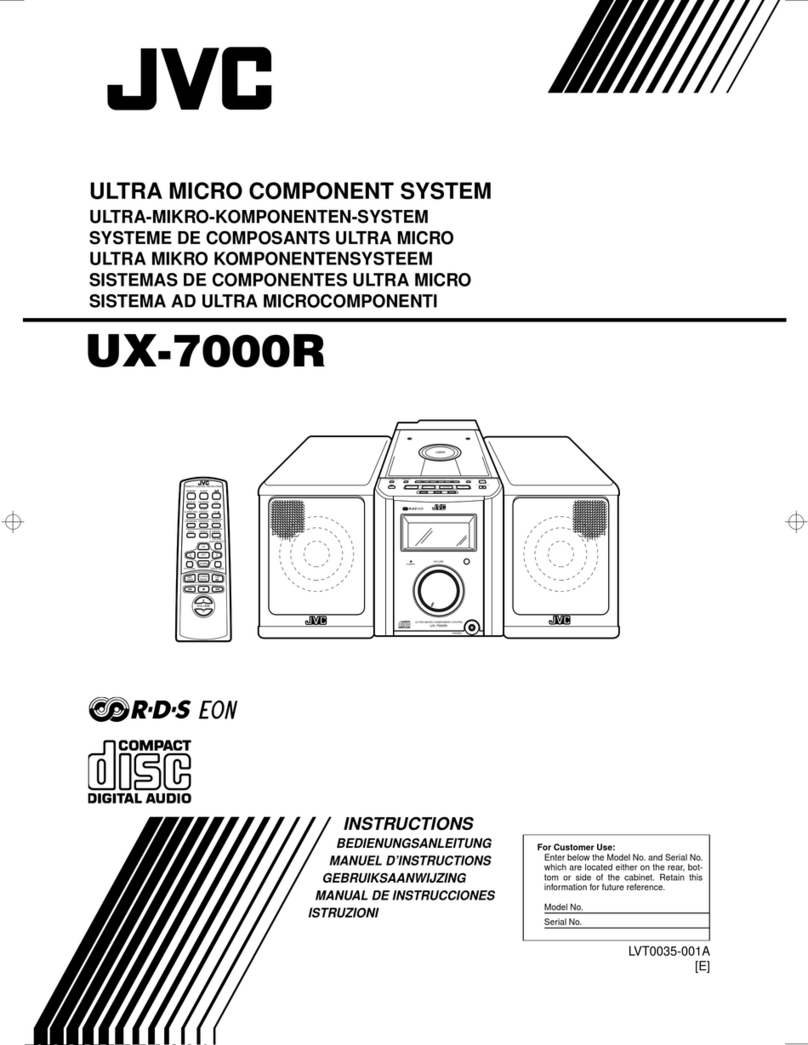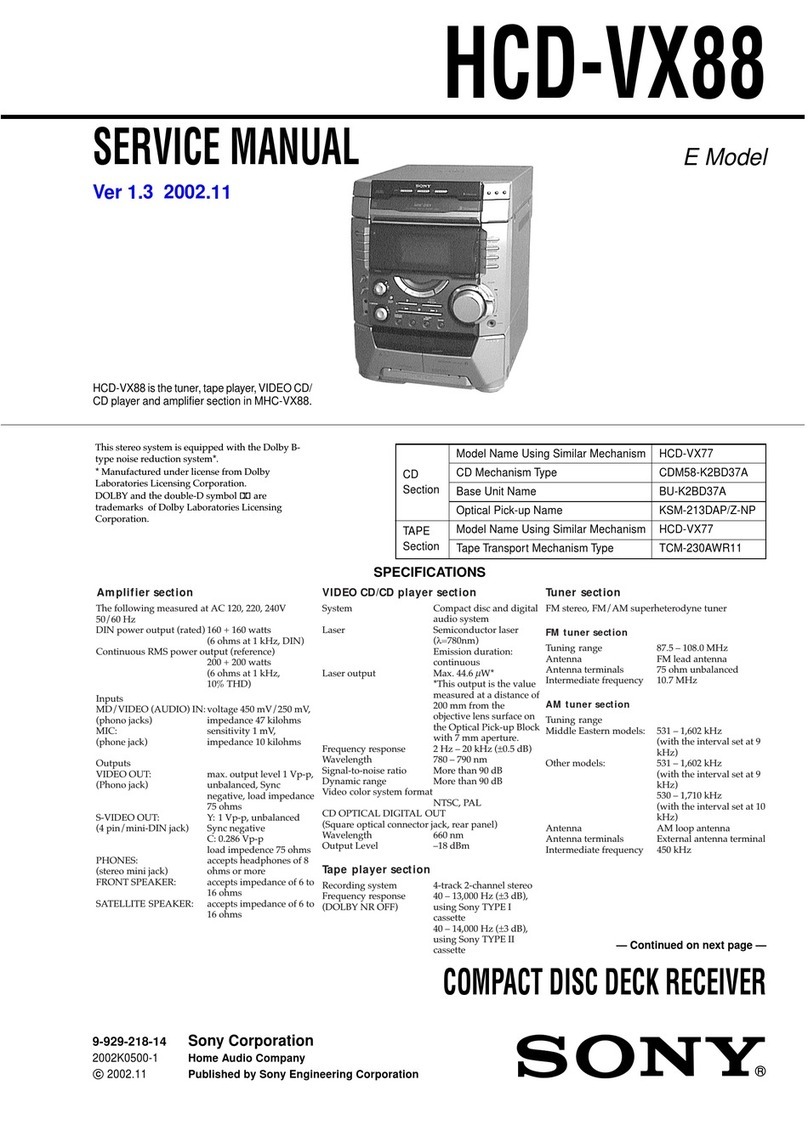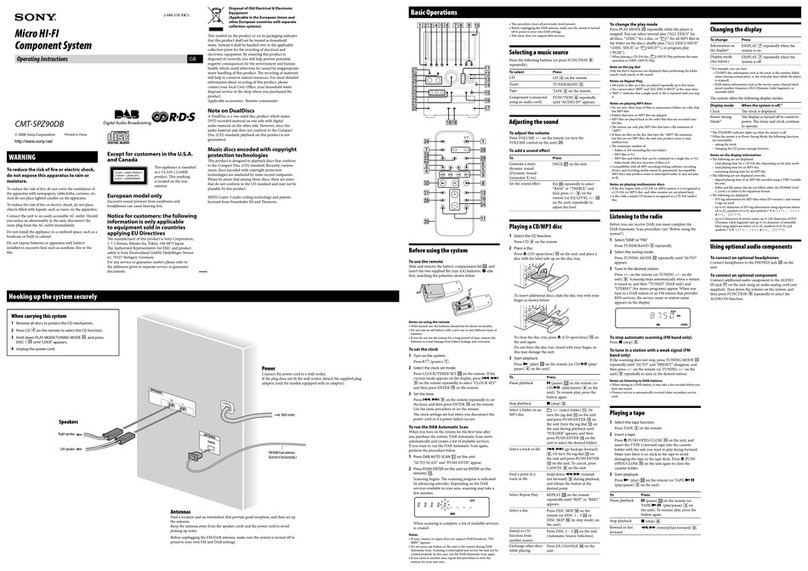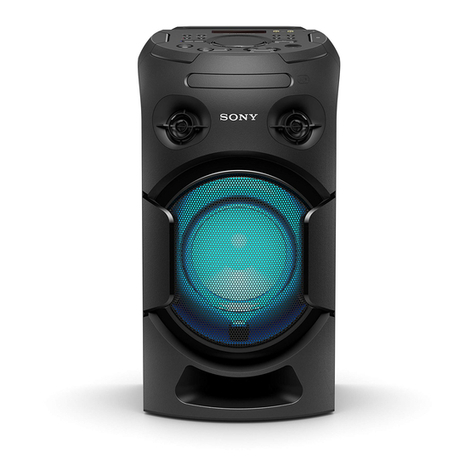
INSTRUCTIONS
LVT1986-019A[J/C]
0109KMMMDWCDT
©2009 Victor Company of Japan, Limited
1
2 4
Connections
Basic and Common Operations
Supplied Accessories
After unpacking, check to be sure that you have all the
following items.
• Remote control, RM-SUXLP5J (× 1)
• Lithium coin battery CR2025 (× 1)
– The battery has been installed in the remote control
when shipped from the factory.
• AM loop antenna (× 1)
• FM antenna (× 1)
• Protection sheet (× 1)
If anything is missing, consult your dealer immediately.
Prepare the Remote Control
When you use the remote control for the first time, pull out
the insulation sheet.
To Replace the Battery in the Remote Control
NOTES:
•Store the battery in a place where children cannot reach. If
a child accidentally swallows the battery, consult a doctor
immediately.
•To prevent the battery from overheating, cracking, or starting
a fire:
– Do not recharge, short, disassemble or heat the battery or
dispose of it in a fire.
– Do not leave the battery with other metallic materials.
– Wrap the battery with tape and insulate when throwing
away or saving it.
– Do not poke the battery with tweezers or similar tools.
•Dispose of battery in the proper manner, according to federal,
state, and local regulations.
Basic Disc Operations
To Press Indication/Result
Play back the disc
• Current track number and elapsed playing
time appear.
• During playback, press again to pause.
Stop playback • While playback is stopped, total track number
and total playing time (for MP3/WMA files,
group number and track number) appear.
Select a track Select the next tracks.
To go back to the beginning of the current or
previous tracks.
Select a group
(MP3/WMA only)
Select the next groups.
Select the previous groups.
Forward search/
Reverse search
Press and hold to fast-forward the track during
playback.
To stop searching, release the button.
Press to fast-forward the track during playback.
To stop searching, press 6.
Press and hold to fast-reverse the track during
playback.
To stop searching, release the button.
Press to fast-reverse the track during playback.
To stop searching, press 6.
Change display
information
Press repeatedly.
NOTES:
•If no disc is inserted, “NO DISC” appears on the main display.
•If MP3/WMA files are not recorded on the disc, “NO PLAY” appears on the main
display.
Getting Started Playing Back a Disc
MICRO COMPONENT SYSTEM
UX-LP5
—Consists of CA-UXLP5 and SP-UXLP5
This System can play back...
– CD.
– CD-R/CD-RW recorded in audio CD format (CD-DA) or recorded MP3/WMA files
in ISO 9660 format.
• When playing back an MP3 or WMA track, MP3 or WMA indicator lights up.
Loading a Disc (on the System only)
1Press to open the disc tray.
2• When using an 8 cm (3 3/16 inch) disc, place it
on the inner circle of the disc tray.
3Press to close the disc tray.
Prohibiting Disc Ejection (on the System only)
You can lock the disc tray so that no one can eject the loaded disc while the
System is on standby.
Press these buttons for 2 seconds while the System is on
standby.
To cancel the prohibition, repeat the same procedure.
3
Playing Repeatedly—Repeat Play
1
Press repeatedly to specify the repeat mode as follows:
: Repeats the current (or specified) track.
: Repeats all tracks in the current group
(MP3/WMA only).
ALL: Repeats all tracks.
No indicator (Off): Normal playback
2
Programming the Playing Order—Program Play
1
During stops, press so that the PRGM (program) indicator
lights up.
2
or
Select a track number.
3
Press to program the selected track.
4Repeat steps 2and 3to program other tracks you want.
• If you try to program a 32nd track, “PRG FULL” will appear.
5
The tracks are played back in the programmed order.
Operations for Program Play (while program stop mode)
• To check the programmed contents, press SET repeatedly.
• To add tracks, after “- - -” appears on the display by pressing SET repeatedly,
repeat steps 2and 3above.
• To erase or exit the program, press 7.
– The stored program is not kept.
Playing at Random—Random Play
1
Press so that the RND (random) indicator lights up and playback
starts in random order.
Operations for Random Play
• To skip a track, press ¢.
• To go back to the beginning of the current track, press 4.
• To exit from random play, press RANDOM so that the RND (random) indicator
disappears during playback.
Thank you for purchasing a JVC product.
To Press Indication/Result
System Remote
Turn on or off
(standby) the power
The STANDBY lamp on the System turns off/on.
Select a source
See “Playing Back a Disc on page 4 and “Listening to an iPod/Viewing
Images on the iPod” on page 5.
For the remote control
• For “FM/AM,” see “Listening to FM
and AM Broadcasts” on page 5.
• For “AUDIO IN,” see “Listening to
Other Equipment” on page 5.
Adjust the volume
Adjustable range: Level 0 (“VOL MIN”) to level 40 (“VOL MAX”).
Drop the volume in
a moment —
To restore the volume, press again, or adjust the volume level.
Emphasize the
sound (Sound
Turbo)
—
The S.TURBO indicator lights up.
To cancel this function, press again.
Reinforce the bass
sound (Hyper Bass
Sound)
—
The BASS indicator lights up.
To cancel this function, press again.
Adjust the tone
(Bass/Treble)
—
Press once for adjusting the bass level; twice for treble level, then, press
VOLUME +/–.
Adjustable range: –3 to +3.
Dim the display
You can dim the display window and illumination lamp.
While the System is turned on...
Set the clock and
timer —
For setting the clock, see “Setting the Clock and Using Timers” on page 6.
Change the display
information
—
The display information changes as follows:
FM: Clock =Frequency
AM: Clock =Frequency
CD: Current track elapsed time =CD total remaining time =Current track
remaining time
MP3/WMA: Current track elapsed time =ID3 tag =Current group/track
Set the ECO
(Ecology) Mode —
Press when the System is on standby.
Setting the ECO (Ecology) Mode allows you to reduce power consumption
by turning the display (clock display) off while on standby.
To cancel this function, press again when the System is on standby.
NOTE:
DO NOT turn off (standby) the System with the volume set to an extremely high level;
otherwise, the sudden blast of sound can damage your hearing, speakers and headphones
when you turn on the System or start playback.
To a wall outlet
Plug the AC power cord only after all connections are complete.
Rear view
Outdoor FM antenna
(not supplied)
Disconnect the supplied FM antenna,
and connect to an outdoor FM
antenna using a 75 Ω wire with coaxial
type connector.
FM antenna (supplied)
AM loop antenna (supplied)
Turn it until the best reception
is obtained.
NOTE: Keep the AM loop
antenna cable wrapped around
the AM loop antenna frame,
otherwise the effectiveness
and sensitivity of the AM loop
antenna may be reduced.
RESUME Play
Press RESUME to activate RESUME Play so that the RESUME indicator lights up.
When you stop the playback by one of the following operations, this System
stores the beginning of the stopped track on the disc.
– Pressing 7once
– Changing the source
When you start playback again, playback starts from the beginning of the
stopped track.
To clear the memory, open the disc tray.
• When you clear the memory and start playback, playback starts from the first
track
To deactivate RESUME Play, press RESUME again.
NOTE:
This function does not work in Program Play.
CAUTION:
Danger of explosion if battery is incorrectly replaced.
Replace only with the same or equivalent type.
NOTES:
•Make sure the antenna conductors do not touch any other terminals, connecting cords and power cord. Also, keep the antennas
away from metallic parts of the System, connecting cords, and the AC power cord. This could cause poor reception.
•Make sure both the speakers are connected correctly and firmly.
•When connecting the speaker cords, match the polarity of the speaker terminals: red color to (+) and black color to (–).
•DO NOT connect more than one speaker to each terminal.
•DO NOT allow the conductor of the speaker cords to be in touch with the metallic parts of the System.
Do not connect the AC power cord until all other connections have been made.
To connect the FM antenna (supplied)
Extend it so that you can obtain the best reception.
For better FM reception
To connect the AM loop antenna To assemble the AM loop antenna
To connect the speaker cords
Using Headphones
Be sure to turn down the volume before connecting or putting on the headphones.
• Connecting the headphones will deactivate the speakers.
• Sound adjustments also affect the sound through the headphones.
STANDBY lamp
Point at the remote sensor on the front panel.
PHONES jack
Stereo mini plug cord
Lithium coin battery
(product number: CR2025)
Press and hold
Insert
Release
Red
Black From left
speaker
From right
speaker
LVT1986-019A EN_UX-LP5[J/C]f
Display Demonstration
When you plug in the System, the display demonstration automatically starts.
To cancel the display demonstration, press and hold DEMO until “DEMO CLR” is
displayed while the System is on standby.
• When the ECO Mode is activated, the display demonstration does not work (and
you cannot deactivate it).
• When the display demonstration is activated, it also starts if no operation is done
for about 2 minutes while the System is turned on.
VOLUME
DISPLAY
DIMMERREPEATRANDOM
PROGRAM
AUDIO IN
TUNER MODE
RESUME
MENU/CANCEL
AUTOSTBY
SLEEP
HBS
REMOTE CONTROL
RM-SUXLP5J
SOUBD
TURBO BASS/TREBLE
CLOCK/
TIMER
FADE
MUTING
UP
CD
iPod
TUNER
SET
DOWN
To connect the
monitor (not
supplied)
Video cord
(not supplied)
Insulation sheet
The operations on pages 4 to 6 are explained using the remote control, unless
mentioned otherwise. However, if the System has the same or similar button names,
they can also be used for the operations.
ENGLISH
Monitor
For turning off the demonstration display, see “Display
Demonstration” on page 3.
Black
White
For customer use:
Enter below the Model No. and Serial No. which are
located either on the rear, bottom or side of the cabinet.
Retain this information for future reference.
Model No.
Serial No.
For U.S.A.
This equipment has been tested and found to comply with
the limits for a Class B digital device, pursuant to part 15 of
the FCC Rules.
These limits are designed to provide reasonable protection
against harmful interference in a residential installation. This
equipment generates, uses and can radiate radio frequency
energy and, if not installed and used in accordance with
the instructions, may cause harmful interference to radio
communications. However, there is no guarantee that
interference will not occur in a particular installation. If this
equipment does cause harmful interference to radio or
television reception, which can be determined by turning
the equipment off and on, the user is encouraged to try to
correct the interference by one or more of the following
measures:
Reorient or relocate the receiving antenna.
Increase the separation between the equipment and
receiver. Connect the equipment into an outlet on a circuit
different from that to which the receiver is connected.
Consult the dealer or an experienced radio/TV technician
for help.
Warnings, Cautions and Others
Mises en garde, précautions et indications
diverses
The lightning flash with arrowhead symbol,
within an equilateral triangle is intended to
alert the user to the presence of uninsulated
“dangerous voltage” within the products
enclosure that may be of sufficient magnitude
to constitute a risk of electric shock to persons.
The exclamation point within an equilateral
triangle is intended to alert the user to
the presence of important operating and
maintenance (servicing) instructions in the
literature accompanying the appliance.
Le symbole de l’éclair à l’intérieur d’un triangle
équilatéral est destiné à alerter l’utilisateur sur
la présence d’une “tension dangereuse” non
isolée dans le boîtier du produit. Cette tension
est suffisante pour provoquer l’électrocution
de personnes.
Le point d’exclamation à l’intérieur d’un
triangle équilatéral est destiné à alerter
l’utilisateur sur la présence d’opérations
d’entretien importantes au sujet desquelles
des renseignements se trouvent dans le
manuel d’instructions.
[European Union only]
[Union européenne seulement]
IMPORTANT FOR LASER PRODUCTS
1. CLASS 1 LASER PRODUCT
2. CAUTION: Do not open the top cover or cabinet. There
are no user serviceable parts inside the unit; leave all
servicing to qualified service personnel.
3. CAUTION: Visible and/or invisible class 1M laser radiation
when open. Do not view directly with optical instruments.
4. REPRODUCTION OF LABEL: CAUTION LABEL, PLACED
INSIDE THE UNIT.
IMPORTANT POUR PRODUITS LASER
1. PRODUIT LASER CLASSE 1
2. ATTENTION: N’ouvrez pas le couvercle supérieur ni
le coffret de l’appareil. Il n’y a aucune pièce réparable
par l’utilisateur à l’intérieur de l’appareil; confiez toute
réparation à un personnel qualifié.
3. ATTENTION: Rayonnement laser visible et/ou invisible
de classe 1M une fois ouvert. Ne pas regarder directement
dans le faisceau avec des instruments optiques.
4. REPRODUCTION DE L’ÉTIQUETTE: ÉTIQUETTE DE
PRÉCAUTION PLACÉE À L’INTERIEUR DE L’APPAREIL.
CAUTION:
Changes or modifications not approved by JVC could void
the user’s authority to operate the equipment.
CAUTION
The button in any position does not disconnect the mains
line.
Disconnect the mains plug to shut the power off completely
(the STANDBY lamp goes off).
The MAINS plug or an appliance coupler is used as the
disconnect device, the disconnect device shall remain readily
operable.
• When the system is on standby, the STANDBY lamp lights
red.
• When the system is turned on, the STANDBY lamp goes off.
The power can be remote controlled.
ATTENTION
La touche , quelle que soit sa position, ne coupe pas la
ligne principale.
Débrancher la fiche principale pour couper complètement
l’alimentation du secteur (le témoin STANDBY s’éteint).
La fiche secteur ou un coupleur est utilisé comme dispositif
de déconnexion de l’appareil, et l’appareil déconnecté doit
être prêt à être utilisé.
• Quand l’appareil est en mode d’attente, le témoin STANDBY
est allumé en rouge.
• Quand l’appareil est sous tension, le témoin STANDBY
s’éteint.
L’alimentation peut être commandée à distance.
CAUTION: Proper Ventilation
To avoid risk of electric shock and fire, and to prevent
damage, locate the apparatus as follows:
1. Front: No obstructions and open spacing.
2. Sides/Top/Back: No obstructions should be placed in the
areas shown by the dimensions below.
3. Bottom: Place on the level surface. Maintain an adequate
air path for ventilation by placing on a stand with a
height of 10 cm or more.
ATTENTION: Aération correcte
Pour prévenir tout risque de décharge électrique ou
d'incendie et éviter toute détérioration, installez l'appareil
de la manière suivante:
1. Avant: Bien dégagé de tout objet.
2. Côtés/dessus/dessous: Assurez-vous que rien ne bloque
les espaces indiqués sur le schéma ci-dessous.
3. Dessous: Posez l’appareil sur une surface plane et
horizontale. Veillez à ce que sa ventilation correcte puisse
se faire en le plaçant sur un support d’au moins dix
centimètres de hauter.
CAUTION:
•
Do not block the ventilation openings or holes. (If the
ventilation openings or holes are blocked by a newspaper or
cloth, etc., the heat may not be able to get out.)
• Do not place any naked flame sources, such as lighted
candles, on the apparatus.
• When discarding batteries, environmental problems
must be considered and local rules or laws governing the
disposal of these batteries must be followed strictly.
• Do not expose this apparatus to rain, moisture, dripping
or splashing and that no objects filled with liquids, such as
vases, shall be placed on the apparatus.
Front view/Face Side view/Côté
WARNING: TO REDUCE THE RISK OF FIRE OR
ELECTRIC SHOCK, DO NOT EXPOSE THIS APPLIANCE
TO RAIN OR MOISTURE.
For USA-California Only
This product contains a CR Coin Cell Lithium Battery which
contains Perchlorate Material – special handling may
apply.
See www.dtsc.ca.gov/hazardouswaste/perchlorate
CAUTION: Excessive sound pressure from earphones or
headphones can cause hearing loss.
ATTENTION: Une pression acoustique excessive des écouteurs
ou du casque d'écoute peut entraîner une perte auditive.
CAUTION: Battery shall not be exposed to excessive heat
such as sunshine, fire, or the like.
ATTENTION
: Les piles ne doivent en aucun cas être
exposées à une chaleur excessive (lumière du solei, feu, etc.).
CAUTION
To reduce the risk of electrical shocks, fire, etc.:
1. Do not remove screws, covers or cabinet.
2. Do not expose this appliance to rain or moisture.
ATTENTION
Afin d’éviter tout risque d’électrocution, d’incendie, etc.:
1. Ne pas enlever les vis ni les panneaux et ne pas ouvrir le
coffret de l’appareil.
2. Ne pas exposer l’appareil à la pluie ni à l’humidité.
ATTENTION:
• Ne bloquez pas les orifices ou les trous de ventilation. (Si
les orifices ou les trous de ventilation sont bloqués par un
journal un tissu, etc., la chaleur peut ne pas être évacuée
correctement de l’appareil.)
• Ne placez aucune source de flamme nue, telle qu’une
bougie, sur l’appareil.
• Lors de la mise au rebut des piles, veuillez prendre en
considération les problèmes de l’environnement et suivre
strictement les règles et les lois locales sur la mise au
rebut des piles.
•
N’exposez pas cet appareil à la pluie, à l’humidité, à un
éqgouttement ou à des éclaboussures et ne placez pas
des objets remplis de liquide, tels qu’un vase, sur l’appareil.


